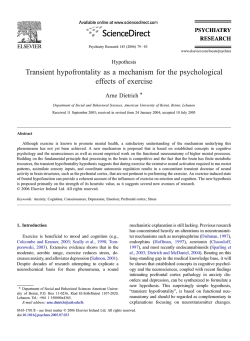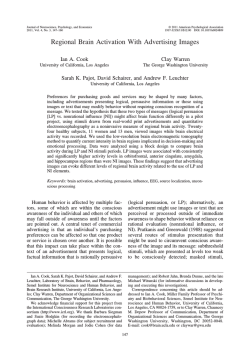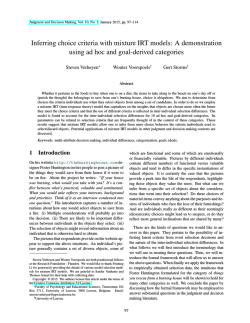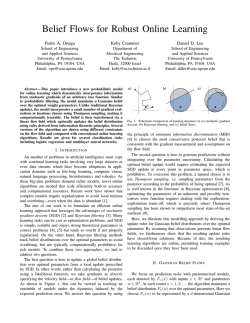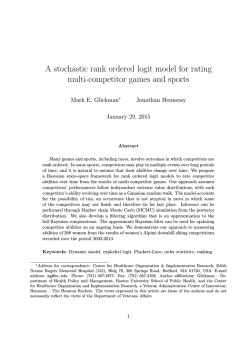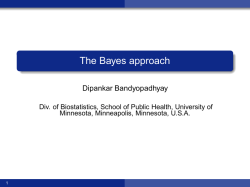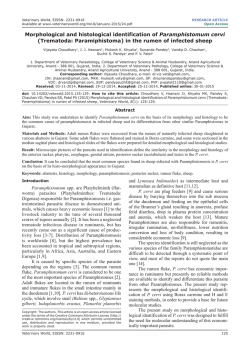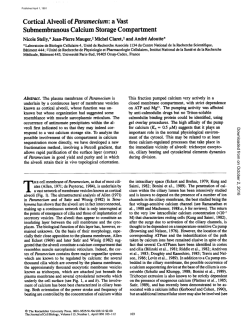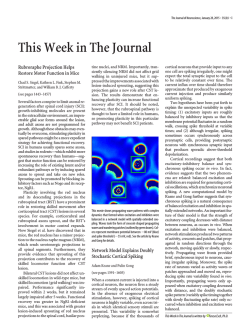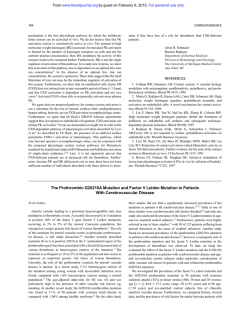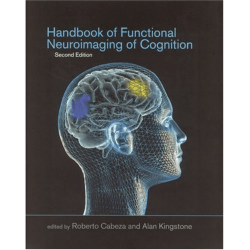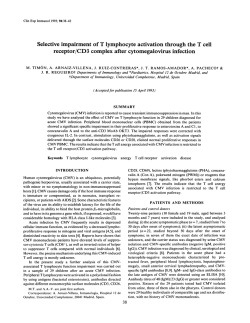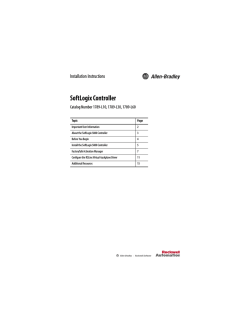
Neural correlates of self-reflection
Brain (2002), 125, 1808±1814 Neural correlates of self-re¯ection Sterling C. Johnson,1,2 Leslie C. Baxter,1 Lana S. Wilder,1 James G. Pipe,2 Joseph E. Heiserman2 and George P. Prigatano1 Departments of 1Clinical Neuropsychology and 2Magnetic Resonance Imaging, Barrow Neurological Institute, St Joseph's Hospital and Medical Center, Phoenix, AZ, USA Summary The capacity to re¯ect on one's sense of self is an important component of self-awareness. In this paper, we investigate some of the neurocognitive processes underlying re¯ection on the self using functional MRI. Eleven healthy volunteers were scanned with echoplanar imaging using the blood oxygen level-dependent contrast method. The task consisted of aurally delivered statements requiring a yes±no decision. In the experimental condition, participants responded to a variety of statements requiring knowledge of and re¯ection on their own abilities, traits and attitudes (e.g. `I forget important things', `I'm a good friend', `I have a quick temper'). In the control condition, participants responded to statements requiring a basic level of semantic knowledge (e.g. `Ten seconds is more than a Correspondence to: Sterling C. Johnson, PhD, Clinical Neuropsychology, Barrow Neurological Institute, St Joseph's Hospital and Medical Center, 222 W. Thomas Road 315, Phoenix, AZ 85013, USA E-mail: [email protected] minute', `You need water to live'). The latter condition was intended to control for auditory comprehension, attentional demands, decision-making, the motoric response, and any common retrieval processes. Individual analyses revealed consistent anterior medial prefrontal and posterior cingulate activation for all participants. The overall activity for the group, using a random-effects model, occurred in anterior medial prefrontal cortex (t = 13.0, corrected P = 0.05; x, y, z, 0, 54, 8, respectively) and the posterior cingulate (t = 14.7, P = 0.02; x, y, z, ±2, ±62, 32, respectively; 967 voxel extent). These data are consistent with lesion studies of impaired awareness, and suggest that the medial prefrontal and posterior cingulate cortex are part of a neural system subserving self-re¯ective thought. Keywords: fMRI; medial prefrontal cortex; posterior cingulate; self-awareness; self-re¯ection Abbreviation: AMPFC = anterior medial prefrontal cortex Introduction The capacity to consciously re¯ect on one's sense of self is an important aspect of self-awareness. A sense of self is a collection of schemata regarding one's abilities, traits and attitudes that guides our behaviours, choices and social interactions. The accuracy of one's sense of self will impact ability to function effectively in the world. A patient for whom self-awareness is compromised may have a sense of self regarding abilities and traits that is not congruent with what others observe (Stuss, 1991; Prigatano, 1999). For example, a brain-injured patient may feel he/she can competently return to the same level of employment when observations by others indicate otherwise. When asked, brain-injured patients often underestimate their own emotional dyscontrol, cognitive dif®culties and interpersonal de®cits relative to a family member's rating of their abilities (Prigatano, 1996). Inaccurate self-knowledge can signi®cantly impede efforts to rehabilitate brain-injured patients, ã Guarantors of Brain 2002 since they may not appreciate the need for such treatment (Sherer et al., 1998a, b). Hughlings Jackson postulated that a sense of self is dependent on the evolutionary development of the prefrontal cortex (Meares, 1999). Lesion studies have generally supported this hypothesis. Damage to the anterior prefrontal regions has been associated with impaired self-awareness for the appropriateness of social interactions, judgement and planning dif®culties (Prigatano and Schacter, 1991; Stuss, 1991), as well as impaired awareness of the mental states of others (`theory of mind'; Stone et al., 1998; Stuss et al., 2001). Impaired self-awareness appears to occur more frequently following medial prefrontal damage (Damasio et al., 1990), but may not be limited to this region. Although much has been learned from lesion studies, to date there is little functional imaging data on this topic. A recent study found that patients with frontal dementia and a fMRI of self re¯ection change in personality functioning also exhibited greater right prefrontal hypoperfusion (Miller et al., 2001) using SPECT (single-photon emission computed tomography) scanning. Studies using cognitive activation paradigms report activations to self-monitoring of current emotional or somatic states (McGuire et al., 1996; Lane et al., 1997; Blakemore et al., 2000; Gusnard et al., 2001). Activations in these studies were within the anterior cingulate and paracingulate region, Brodmann area (BA) 32 (Frith and Frith, 1999). To date, no studies have addressed the process of conscious re¯ection on one's own traits, abilities and attitudes that comprise a sense of self. For the paradigm reported in this paper, we used stimuli that were similar to what one might ®nd on a self-report personality or mood survey. We asked participants to answer questions regarding stable traits, attitudes and abilities. The control condition involved retrieval of general factual knowledge (semantic knowledge retrieval). In light of previous lesion and imaging studies, we hypothesized that the medial prefrontal cortex would be involved in this task. Methods Subjects Eleven right-handed, healthy volunteer participants (four females, seven males; mean age 35 years, SD = 12; mean education 17 years, SD = 2.3) were recruited from employees within the medical centre. The volunteers provided written informed consent to participate in this institutional review board-approved study. Paradigm In the functional MRI (fMRI) paradigm, the participants were asked to make decisions about themselves on speci®c statements requiring self-evaluation in the domains of mood, social interactions, cognitive and physical abilities. A standard set of statements was administered via headphones to each participant during scanning. The set included items such as `I get angry easily', `I often forget things', `My future is bright', `I'd rather be alone', `I catch on quickly', `I can be trusted' and `I'm good at my job'. In the control condition (used to control for auditory processing, attention, language comprehension, decision making, the motor response and retrieval), participants made decisions about statements of factual knowledge. Statements included items such as `Ten seconds is more than a minute' and `You need water to live'. Participants responded to each statement with a `yes' (right hand) or `no' (left hand) button press. A constant visual reminder of which button to press for each response was displayed through the goggle projection system throughout the entire scan. Statements were digitized and delivered aurally at 44.1 kHz. They were presented every 4 s in blocks of six for each condition. The statements were, on average, 2 s in duration, 1809 leaving 2 s to respond. The experimental and control conditions alternated over ®ve cycles. The task was presented twice using equivalent forms (order of form administration was counterbalanced across subjects). Scanning technique Participants were positioned in a GE 1.5 Tesla NVi scanner with foam padding around the head to minimize participant motion. Stimuli were delivered into the scanner via a laptop computer connected to an MR-compatible goggle and headphone system from Resonance Technology (Northridge, CA, USA). The software Presentation (http:// www.neurobehaviouralsystems.com) was used for delivering the auditory stimuli and recording responses. Input from the scanner via a low amplitude electrical pulse allowed the stimulus delivery software to monitor the scanner at every slice acquisition and deliver the auditory stimuli with accurate timing. A single-button MRI-compatible response device was placed in each hand for making yes±no responses. Imaging parameters T2* weighted images were acquired with a gradient echo, echo-planar pulse sequence to elicit blood oxygen leveldependent (BOLD) contrast. The scanning parameters were as follows: TE (echo time) = 40 ms; TR (repetition time) = 3000 ms; ¯ip angle = 90°; acquisition matrix = 64 3 64 voxels; ®eld of view (FOV) = 240 mm. Thirty-two slices of the brain were acquired axially within the TR at each time point, with near isotropic voxel resolution of 3.75 3 3.75 3 4.2 mm. Eighty-two time points were collected over a 4 min scanning run (images from the ®rst 6 s were discarded). High-resolution structural images were acquired for overlay of the statistical results. The images were collected using a SPGR (spoiled gradient) T1-weighted, 3D acquisition with the following parameters: TR = 24 ms, TE = 6 ms, ¯ip angle = 40°, NEX = 1, slice thickness = 1.9 mm, 0 skip between slices, FOV = 24 cm, in-plane resolution = 0.9375 mm2 voxels. The T1 and T2* weighted images were co-registered using a least squares minimization routine. Analysis Images were analysed using Statistical Parametric Mapping software (SPM99, University College London, UK; http:// www.®l.ion.ucl.ac.uk). Prior to statistical analysis, the timeseries of images were corrected for motion, normalized into a standard atlas space (using the International Consortium for Brain Mapping template as implemented in SPM99), and then spatially smoothed using an 8-mm full-width at halfmaximum Gaussian kernel. Individual time-series analysis was performed on each participant. The boxcar model included bandpass ®ltering to remove high and low frequency signal, and convolution with a haemodynamic response function on a voxel by voxel basis 1810 S. C. Johnson et al. Table 1 Coordinates (MNI space) and peak activation statistics for prefrontal and cingulate cortex for each participant Talairach coordinates Participant Region x y z t-value P-value (corrected) S1 AMPFC PC AMPFC PC AMPFC PC AMPFC PC AMPFC PC AMPFC PC AMPFC PC AMPFC PC AMPFC PC AMPFC PC AMPFC PC 0 ±4 4 ±4 0 ±4 ±10 0 2 ±4 6 ±8 ±6 ±4 2 10 0 ±4 8 14 ±8 ±4 66 ±48 52 ±74 54 ±46 64 ±58 60 ±54 56 ±55 60 ±52 62 ±58 76 ±44 64 ±54 60 ±56 10 36 ±4 38 18 ±6 26 36 18 32 38 24 32 30 20 32 8 24 34 20 30 10 5.72 9.90 5.77 5.49 8.68 5.38 7.61 8.04 7.62 8.40 7.94 5.45 7.72 5.55 9.76 7.97 13.63 12.65 8.98 5.98 6.24 8.31 0.001 0.000 0.012 0.032 0.000 0.005 0.000 0.000 0.000 0.000 0.000 0.004 0.000 0.002 0.000 0.000 0.000 0.000 0.000 0.006 0.000 0.000 S2 S3 S4 S5 S6 S7 S8 S9 S10 S11 AMPFC = anterior medial prefrontal cortex; PC = posterior cingulate cortex; MNI = Montreal Neurological Institute. using the general linear model (Friston et al., 1995). The individual results were of most interest to us. However, we also characterized the average group response using a random-effects approach (Holmes and Friston, 1998). Results Inspection of performance data indicated an equivalent proportion of `yes' (right button) responses between conditions across participants (mean of 50% `yes' responses in the self-re¯ection condition, mean of 51% `yes' responses in the semantic condition). These proportions did not differ signi®cantly. The reaction time for the `self' condition was 659 ms, and for the semantic condition it was 602 ms. The difference between the two conditions was not signi®cant (P = 0.61). All 11 participants individually activated the anterior medial prefrontal cortex and posterior cingulate above a Pvalue threshold (corrected for multiple comparisons) of 0.05, as shown in Table 1. Figure 1 depicts the individual activations for the 11 subjects prior to any spatial standardization. Activation maps are overlayed on their own coregistered T1-weighted MRI scans. Peak activations in the anterior medial prefrontal cortex (AMPFC) occurred just to the right of midline in ®ve of the participants, three were just left of midline, and the remaining three were at midline (see Table 1 for spatially normalized activation coordinates). A summary of the group activity is shown in Fig. 2. The main effects of activation in the group analysis were highly consistent with the individual analyses, as expected. Activations included the AMPFC (t = 13.0, corrected P = 0.05; x, y, z, 0, 54, 8) and posterior cingulate (t = 14.7, corrected P = 0.02; x, y, z, ±2, ±62, 32). No other regions survived the correction for multiple comparisons. Discussion Consistent and robust anterior medial prefrontal and posterior cingulate activation during self-re¯ection was observed in all 11 participants. While the peak of the activation varied somewhat between individuals, the preponderance of activity was always within AMPFC, BA 9 and 10, and posterior cingulate, in the area of BA 23, 30 and 31. Activation of the anterior medial prefrontal region was consistent with our hypothesis and with lesion studies of patients with impaired self-awareness (Stuss, 1991). The consistency and magnitude of the activation was, however, somewhat greater than expected. Previous functional imaging studies involving self-evaluation have focused on appraising current internal states rather than more stable traits (Frith and Frith, 1999). These prior studies have collectively demonstrated anterior medial prefrontal activation. Together, the current results and previous studies suggest that mentalizing about the self, fMRI of self re¯ection Fig. 1 Midsagittal view of each participant showing prefrontal activation during self-re¯ective thought. The activations are superimposed on top of each participant's anatomical scan. Note the consistent activation of the prefrontal cortex across subjects. For the purposes of this display, the statistical threshold was set to an uncorrected P-value of 0.0005. These results are prior to any spatial standardization. The coordinates for the spatially standardized results for each individual are shown in Table 1. whether it be traits or current states, may activate the same or similar medial frontal network. Developmental theorists have written that a sense of self begins in early childhood as a multidimensional set of schemata, is de®ned further through accommodation of experiences and perceptions in childhood and adolescence, and gains permanence in early adulthood (Rychlak, 1981; Kagan, 1982; Miller et al., 2001; Zeman, 2001). Piaget de®ned schema as the potential to act or to be a certain way (Rychlak, 1981). Over time, schemata may become unlinked 1811 to speci®c autobiographical events, and become part of a nonepisodic knowledge base, analogous to semantic knowledge. Functional imaging studies of episodic autobiographical memory retrieval have consistently reported posterior cingulate activation (Maddock, 1999; Maddock et al., 2001; Maguire et al., 2001). The posterior cingulate has reciprocal connections with other memory areas, including the dorsolateral prefrontal cortex, the posterior parahippocampal cortex, presubiculum and the entorhinal cortex, and with several nuclei of the thalamus (Duvernoy, 1998; Morris et al., 1999; Mesulam, 2000). The posterior cingulate has also been shown to respond to a familiar face or voice (Shah et al., 2001), retrieval of episodic information (Andreasen et al., 1995; Wiggs et al., 1999) as well as retrieval of semantic information (Pihlajamaki et al., 2000). Further, resting hypometabolism in this region has been observed consistently in very early-stage Alzheimer's disease, when dif®culty with memory is the most prominent symptom (Minoshima et al., 1997). Persons who are at genetic risk for Alzheimer's disease also exhibit posterior cingulate hypometabolism (Reiman et al., 1996). Although this study reports activations in the posterior cingulate, the paradigm differs from tasks of autobiographical episodic memory in many respects. Autobiographical memory paradigms used in functional imaging experiments generally entail recollection of vivid, personally relevant episodes from the past. These experiments generally allow for a relatively longer period of time, 4±20 s, for the participant to retrieve the event as well as its context (Maguire et al., 2001; Ryan et al., 2001) In the current study, participants were allowed only 2 s to re¯ect and decide. There was little time for participants to retrieve prior episodes and contexts on which to base their subjective decisions. Furthermore, they were speci®cally instructed to use their ®rst impressions rather than ruminating on the question or justifying their responses with facts. The posterior cingulate appears not only to be important for memory, but also for the perception and evaluation of emotional stimuli. A recent review paper (Maddock, 1999) observed that the posterior cingulate is the most frequently activated region during evaluation of emotional salience of a stimulus. Since this region is also activated in autobiographical retrieval, Maddock (1999) further argued that the posterior cingulate may mediate an `interaction' between memory retrieval and emotion. This notion is relevant to our task, during which participants were required to retrieve and re¯ect on self schemata that may have had an emotional component. Measuring the emotional salience was beyond the scope of this study, but would have been helpful in interpreting the activations observed. We note a consistent observation in research on emotion and memory, that stimuli with greater emotional salience tend to be better recalled (Cahill, 1997, 2000; Maddock and Buonocore, 1997; Maddock et al., 2001). Lasting personal memories typically have a salient affective tone, and it may be dif®cult to separate the retrieval of content from the 1812 S. C. Johnson et al. Fig. 2 Group activations for the self-re¯ection versus general knowledge conditions. This maximum intensity projection represents a random-effects group analysis. Lower right: a midsagittal anatomical view is shown with the group activation superimposed. The results are thresholded at an uncorrected P-value of 0.001, corresponding to a t-statistic of 4.14. The main effect of activation occurred in anterior medial prefrontal cortex (maxima t = 13.0, corrected P = 0.05; x, y, z = 0, 54, 8, respectively; cluster size 2326 voxels) and the posterior cingulate (maxima t = 14.7, corrected P = 0.02; x, y, z = ±2, ±62, 32; cluster size 976 voxels). Other activated regions at this threshold included the thalamus (t = 7.53; x, y, z = 4, ±4, 12), bilateral posterolateral orbital cortex (right orbital: t = 7.67; x, y, z = 28, 18, ±18; left orbital: t = 7.51; x, y, z = ±10, 6, 14), bilateral inferior temporal gyrus (right: t = 10.38; x, y, z = 52, ±6, ±24; left: t = 8.46; x, y, z = ±62, ±14, ±16) and bilateral cerebellum (right: t = 6.13; x, y, z = 24, ±74, ±38; left: t = 6.12; x, y, z = ±32, ±78, ±38). accompanying emotional tone. Nevertheless, future studies should attempt to control for the affective processes during autobiographical memory retrieval in order to de®ne better the role of the posterior cingulate. There are other limitations to these data. Although we instructed participants to respond with their ®rst impressions, and not to rely on speci®c instances to answer each question, we are unable to rule out episodic autobiographical retrieval as a possible response strategy and source of activity in the posterior cingulate. Also, although the reaction times for the experimental and control conditions were equivalent, the self condition may have been more psychologically uncomfortable and revealing than the control task, and therefore more dif®cult. Self-re¯ection, as we have described it here, can be considered a metacognitive function (Stuss et al., 2001), and our results may not be speci®c to self-re¯ection per se. Two previous PET studies examining `theory of mind' tasks reported anterior medial prefrontal and posterior cingulate activity (Fletcher et al., 1995; Goel et al., 1995). The tasks used in these studies required the participant to `mentalize' about the beliefs and desires of others so as to predict their behaviour. Fletcher et al. and Goel et al. found maximal medial prefrontal activity at Talairach (x, y, z) locations ±12, 42, 40 and±6, 46, 28, respectively, slightly posterior and superior to the activation reported in the present study (2, 54, 8). To address the issue of whether the activations seen here represent generically metacognitive functions, or are in fact speci®c to the self-re¯ective thought process, future research should directly compare metacognitive tasks requiring mentalizing about the self with tasks requiring mentalizing about others. We assumed that the healthy individuals in our study would rate themselves accurately. While this assumption may be reasonable for healthy, cognitively normal volunteers, it would probably not hold for patients with altered self-awareness. In fMRI of self re¯ection such cases, other methods may be helpful to differentiate between self-re¯ection and self-awareness, such as incorporating patient and caregiver ratings of the patient's abilities into the statistical analysis. This work is underway in our laboratory. Conclusion The medial prefrontal cortex and posterior cingulate are important brain regions for accessing a sense of self. The frontal activation results are consistent with lesion studies in patients with impaired self-awareness, as well as other functional imaging tasks involving mentalizing about the self or others. The current results suggest that studying aspects of self-awareness is quite feasible, with functional imaging using this type of paradigm. Acknowledgements We wish to thank Sarah Hahn, PhD, and Patty Puppe, RT, for their efforts on this project. We also wish to thank Richard Lane, MD, PhD, for review and critical discussion of an earlier version of the manuscript. This study was supported in part by the National Institute on Aging (AG18540), the National Institute of Mental Health (MH65723), the Arizona Alzheimer's Research Center, and the Barrow Neurological Foundation. References Andreasen NC, O'Leary DS, Cizadlo T, Arndt S, Rezai K, Watkins GL, et al. Remembering the past: two facets of episodic memory explored with positron emission tomography. Am J Psychiatry 1995; 152: 1576±85. Blakemore SJ, Wolpert D, Frith C. Why can't you tickle yourself? [Review]. Neuroreport 2000; 11: R11±6. Cahill L. The neurobiology of emotionally in¯uenced memory. Implications for understanding traumatic memory. [Review]. Ann NY Acad Sci 1997; 821: 238±46. 1813 Goel V, Grafman J, Sadato N, Hallett M. Modeling other minds. Neuroreport 1995; 6: 1741±6. Gusnard DA, Akbudak E, Shulman GL, Raichle ME. Medial prefrontal cortex and self-referential mental activity: relation to a default mode of brain function. Proc Natl Acad Sci USA 2001; 98: 4259±64. Holmes AP, Friston KJ. Generalisability, random effects and population inference. Neuroimage 1998; 7: S754. Kagan J. The emergence of self. J Child Psychol Psychiatry 1982; 23: 363±81. Lane RD, Fink GR, Chau PM, Dolan RJ. Neural activation during selective attention to subjective emotional responses. Neuroreport 1997; 8: 3969±72. Maddock RJ. The retrosplenial cortex and emotion: new insights from functional neuroimaging of the human brain. [Review]. Trends Neurosci 1999; 22: 310±6. Maddock RJ, Buonocore MH. Activation of left posterior cingulate gyrus by the auditory presentation of threat-related words: an fMRI study. Psychiatry Res 1997; 75: 1±14. Maddock RJ, Garrett AS, Buonocore MH. Remembering familiar people: the posterior cingulate cortex and autobiographical memory retrieval. Neuroscience 2001; 104: 667±76. Maguire EA, Vargha-Khadem F, Mishkin M. The effects of bilateral hippocampal damage on fMRI regional activations and interactions during memory retrieval. Brain 2001; 124: 1156±70. McGuire PK, Paulesu E, Frackowiak RS, Frith CD. Brain activity during stimulus independent thought. Neuroreport 1996; 7: 2095±9. Meares R. The contribution of Hughlings Jackson to an understanding of dissociation. Am J Psychiatry 1999; 156: 1850±5. Mesulam M-M. Behavioral neuroanatomy: large scale networks, association cortex, frontal syndromes, the limbic system, and hemispheric specializations. In: Mesulam MM, editor. Principles of Behavioral and Cognitive Neurology. Oxford: Oxford University Press; 2000. p. 1±173. Cahill L. Neurobiological mechanisms of emotionally in¯uenced, long-term memory. [Review]. Prog Brain Res 2000; 126: 29±37. Miller BL, Seeley WW, Mychack P, Rosen HJ, Mena I, Boone K. Neuroanatomy of the self: evidence from patients with frontotemporal dementia. Neurology 2001; 57: 817±21. Damasio AR, Tranel D, Damasio H. Individuals with sociopathic behavior caused by frontal damage fail to respond autonomically to social stimuli. Behav Brain Res 1990; 41: 81±94. Minoshima S, Giordani B, Berent S, Frey KA, Foster NL, Kuhl DE. Metabolic reduction in the posterior cingulate cortex in very early Alzheimer's disease. Ann Neurol 1997; 42: 85±94. Duvernoy HM. The Human Hippocampus. 2nd edn. Berlin: Springer-Verlag; 1998. Morris R, Petrides M, Pandya DN. Architecture and connections of retrosplenial area 30 in the rhesus monkey (Macaca mulatta). Eur J Neurosci 1999; 11: 2506±18. Fletcher PC, Happe F, Frith U, Baker SC, Dolan RJ, Frackowiak RS, et al. Other minds in the brain: a functional imaging study of `theory of mind' in story comprehension. Cognition 1995; 57: 109±28. Friston KJ, Holmes AP, Worsley KJ, Poline JP, Frith CD, Frackowiak RSJ. Statistical parametric maps in functional imaging: a general linear approach. Hum Brain Mapp 1995; 2: 189±210. Frith CD, Frith U. Interacting mindsÐa biological basis. [Review]. Science 1999; 286: 1692±5. Pihlajamaki M, Tanila H, Hanninen T, Kononen M, Laakso M, Partanen K, et al. Verbal ¯uency activates the left medial temporal lobe: a functional magnetic resonance imaging study. Ann Neurol 2000; 47: 470±6. Prigatano GP. Behavioral limitations TBI patients tend to underestimate: a replication and extension to patients with lateralized dysfunction. Clin Neuropsychol 1996; 10: 191±201. Prigatano GP. Disorders of self-awareness after brain injury. In: 1814 S. C. Johnson et al. Prigatano GP. Principles of Neuropsychological Rehabilitation. New York: Oxford University Press, 1999; p. 265±93. Impaired awareness and employment outcome after traumatic brain injury. J Head Trauma Rehabil 1998a; 13: 52±61. Prigatano GP, Schacter DL, editors. Awareness of De®cit After Brain Injury: Clinical and Theoretical Issues. New York: Oxford University Press; 1991. Sherer M, Boake C, Levin E, Silver BV, Ringholz G, High WM Jr. Characteristics of impaired awareness after traumatic brain injury. J Int Neuropsychol Soc 1998b; 4: 380±7. Reiman EM, Caselli RJ, Yun LS, Chen K, Bandy D, Minoshima S, et al. Preclinical evidence of Alzheimer's disease in persons homozygous for the epsilon 4 allele for apolipoprotein E. New Engl J Med 1996; 334: 752±8. Stone VE, Baron-Cohen S, Knight RT. Frontal lobe contributions to theory of mind. J Cogn Neurosci 1998; 10: 640±56. Ryan L, Nadel L, Keil K, Putnam K, Schnyer D, Trouard T, et al. Hippocampal complex and retrieval of recent and very remote autobiographical memories: evidence from functional magnetic resonance imaging in neurologically intact people. Hippocampus 2001; 11: 707±14. Stuss DT. Disturbance of self-awareness after frontal system damage. In: Prigatano GP, Schacter DL, editors. Awareness of De®cit After Brain Injury: Clinical and Theoretical Issues. New York: Oxford University Press; 1991. p. 63±83. Stuss DT, Gallup GG Jr, Alexander MP. The frontal lobes are necessary for `theory of mind'. Brain 2001; 124: 279±86. Rychlak J. Two kinds of constructive theories: Jean Piaget and George Kelly. In: Rychlak J, editor. Personality and psychotherapy. Boston: Houghton Mif¯in; 1981; p. 664±753. Wiggs CL, Weisberg J, Martin A. Neural correlates of semantic and episodic memory retrieval. Neuropsychologia 1999; 37: 103±18. Shah NJ, Marshall JC, Za®ris O, Schwab A, Zilles K, Markowitsch HJ, et al. The neural correlates of person familiarity: a functional magnetic resonance imaging study with clinical implications. Brain 2001; 124: 804±15. Zeman A. Consciousness. [Review]. Brain 2001; 124: 1263±89. Sherer M, Bergloff P, Levin E, High WM Jr, Oden KE, Nick TG. Received May 14, 2001. Revised January 21, 2002. Accepted February 28, 2002
© Copyright 2025
